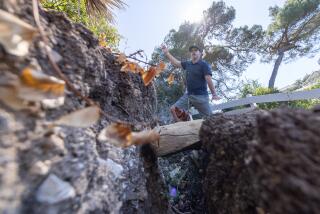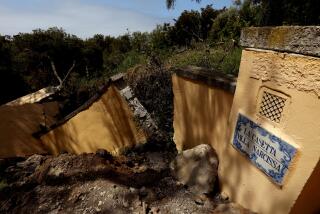Soil Scientist to Dig Up Dirt Data
- Share via
Al Wasner figures that a few dozen times in the next three years, someone will call the sheriff about him.
He’ll be standing on a hillside above a home in Zuma or Malibu or Calabasas with a long, narrow shovel in his hands, digging holes. But he won’t be burying weapons or growing marijuana or doing anything particularly sordid.
Wasner will be digging holes just to see what the dirt looks like.
Maybe as many as 4,000 holes.
“The gravel in here is like rebar in concrete,” Wasner said, crumbling a piece of heavy clay on a hazy morning in Zuma Canyon. “This soil is really old.”
Between now and the year 2000, Wasner plans to dig several thousand 3- to 5-foot-deep holes in the Santa Monica Mountains National Recreation Area as he conducts the first comprehensive regional soil survey in Los Angeles County in 30 years.
Of the recreation area’s 150,000 acres, spread throughout Los Angeles and Ventura counties, half are privately owned. That means that Wasner, a soil scientist for the U.S. Department of Agriculture, will need permission to hike into many backyards in pursuit of information that he hopes will aid developers, homeowners and ecologists.
*
Wasner’s survey, at a cost to the National Park Service of $395,000, will begin this week on the slopes of either Zuma Canyon or the Circle X Ranch near Thousand Oaks, on federal land.
Not only will his detailed maps aid the park service in building trails and replanting areas damaged by fire, but Wasner said assessors use his surveys to assign land values, and engineers refer to it when building roads.
“When they use it [the soil survey], they have a little better chance of the road not sliding down the mountain,” Wasner said.
Dennis Washburn, a director of the Santa Monica Mountains Resource Conservation District, cites the 1983 Big Rock Mesa landslide--which damaged more than 200 Malibu hillside homes--as a disaster that could have been avoided if knowledge of the soil had influenced land use policy.
“Without knowledge of what you’re building upon, you always run the risk of these kinds of failures, and they have consequences in terms of litigation and social costs,” Washburn said.
Steve Lipshie, an engineering geologist with the Los Angeles County Department of Public Works, said Wasner’s data will help the county design the debris basins that protect foothill communities from being inundated by runoff, among other things. At present, Lipshie said, county engineers refer to soil maps published in 1914.
“By identifying the types of soil in the canyons, you can make an estimate of how much sediment is likely to come down,” Lipshie said.
Carrying with him into the field a 7-foot steel pole, a 2-foot pick and a long, narrow shovel he calls a “sharpshooter,” Wasner will dig 40 to 50 holes a month and then fill them back in again. He often works 10-hour days, examining soil and noting things like color and porosity before deciding which of about 60 local classifications the dirt belongs to. Soil in the Santa Monicas, he said, will range from pale yellowish sand to heavy, fertile black clay.
Only two such detailed regional surveys have been conducted in Los Angeles County--one in Malibu in 1967 and one in the San Fernando Valley in 1970.
But the ground can change over time. “If you water your lawn for 30 years, the soil is lots different than it was,” Wasner said. “It’s a real different beast under there.”
Malibu resident Ralph Waycott questioned whether the soil survey would be useful to individual homeowners. “I’m not sure that the soil samples required for remodeling or construction would be satisfied by the type of random sampling done by the National Park Service,” he said. But Waycott said he supports the park service’s efforts, as long as it doesn’t mean any holes in his lawn.
The soil survey data will be available from the Department of Agriculture at no cost once Wasner finishes his digging odyssey.
After getting OKs from landowners and permits from park service archeologists who must ensure that Wasner isn’t encroaching on archeologically important sites, Wasner will face the combined threats of ticks, steep inclines and--most important--inquisitive landowners.
“Sometimes I’m hoarse by the end of the day from explaining to people,” he said. “Sometimes I try to hide so I can get some work done.”
More to Read
Sign up for Essential California
The most important California stories and recommendations in your inbox every morning.
You may occasionally receive promotional content from the Los Angeles Times.










